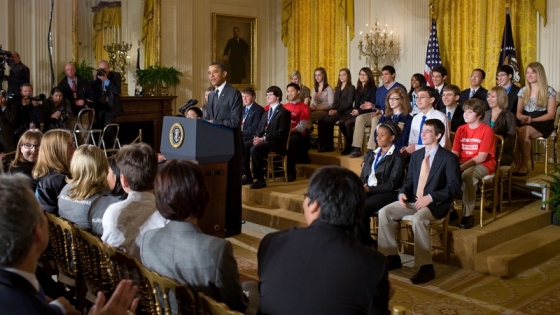For competing in the Worldwide Imagine Cup Finals, all the developers/competitors were promised Windows Phone 7 (rumored to be delivered to us mid-August). After playing with it for a full 24-hours, I can honestly say I am impressed and can't wait to get it on my doorstep. I'll post a full review of it then.
Below is an excerpt of an article by Peter Bright on Windows Phone 7 that I ran across this morning which examines Microsoft approach and solution in the mobile market. The original article can be viewed at
ArsTechnica--

Microsoft has a long and illustrious history of operating system sales. The model has served the company well on the PC, but if it wants to make money in the phone market, it needs to start thinking like a consumer electronics company. That means selling Microsoft phones.
The first-generation Zunes were not entirely inspiring, as they were rush jobs based on existing Toshiba MP3 players. But the Zune HD was an all-new design, and it was a high-quality, attractive, well-designed piece of hardware. If nothing else, it demonstrated that Redmond can, in fact, produce decent consumer electronics devices, with a look that appeals, an interface that works well, and attractive PC software.
The Xbox 360, for all its hardware problems, makes a similar case. The red ring of death flaws certainly detract from the Xbox 360 as a piece of design. But ultimately, it's a well-liked, well-designed appliance, and it shows off the benefits of vertical integration. As with the Zune HD, the Xbox 360 shows that Microsoft can build a tightly integrated combination of hardware, software, and online services. Though it may not ever make much money, for various reasons, it nonetheless serves to demonstrate that Redmond can do the consumer electronics thing properly.
Still, there are other areas where Redmond is persisting with its licensed operating system model. Phones are, of course, the big one. Windows Mobile is sold to OEMs to stick on the devices they build, and it's up to the manufacturers to produce elegant, attractive hardware. Windows Mobile is also highly customizable, and many handset manufacturers exploit this to add their own custom front-ends to make up for various flaws in the standard Windows Mobile user interface.
Microsoft has had a little success with this model, but that success has been waning. The introduction of the iPhone was the turning point; it offered the same end-to-end integration that the iPod had, and it brought it to the phone. A strong user interface, compelling industrial design, integration with an online music store, and an easy-to-use application store, all of which showed the value of vertical integration in a smartphone. Consumers liked what they saw.
Windows Phone 7 is Microsoft's first step away from the model of old. With its new phone operating system, the company is taking control of the user interface (no OEM customization will be possible), the online store (both for applications and for music), and the PC-side software. However, the company is still leaving the hardware to third parties.
A bunch of hardware companies are on board for the first release of Windows Phone 7, and there will be a range of handsets for sale when it launches. But whether those partners will stick around is less clear. Windows Phone 7 offers much less scope for an OEM to differentiate its products. The custom front-ends that proliferated under Windows Mobile, and are commonplace in the Android world, aren't an option, and by discarding them, the vendors lose a lot of branding opportunity.
The tight hardware specification also comes into play here. Screen resolutions, camera quality, hardware sensors, and buttons are all governed by Microsoft's specification. Vendors will have a few options—hardware keyboards are optional, and they can offer better cameras than the baseline—but not many. More hardware variants will be possible in the future, as Microsoft introduces new form factors, but there's no (public) time frame for when these will arrive. Microsoft's priority at the moment is producing a better operating system rather than an operating system that fits into more form factors. After all, Apple has shown that you can take a huge chunk of the market with only one.
With the loss of the software customization and the lack of hardware variation, OEMs might find themselves with no effective means of establishing a branding or carving out a niche for themselves. Though they're supporting Windows Phone 7 right now, there's a good chance that they will lose interest once their hardware has been commoditized.
This commoditization is, after all, what Microsoft wants: Redmond wants people to think of the phones, first and foremost, as Windows Phone 7 devices, and for the vendor differences to take a back seat. But unless the company can do something to keep the hardware companies sweet, it may find that they drop the platform in favor of one where they can do more to create their own identity: Android being the obvious contender.
The best way to guard against defections by the hardware companies without diluting the strong platform branding is to cut them out altogether. Make the phone brand the same as the hardware brand, and the whole issue is completely avoided.
And then there's the most important reason of all to go with vertical integration: money. There just isn't a whole lot of money in licensing a phone operating system like this. We don't know, because the information isn't public, just how much a Windows Phone 7 license will cost an OEM, but it's generally assumed to be a few tens of dollars. Even assuming $30 per unit (which from what I can tell is on the high side), Microsoft's partners would have to ship a whopping 30 million handsets to make this a billion-dollar business.
That's more or less the number of units that Apple sells, and Apple's a market leader with a strong, mature product. Microsoft is coming to market with what is essentially version one, and though its product has its strengths, it also has a number of well-known weaknesses; it's missing some functionality, and it's going up against the App Store juggernaut.
Apple, for its part, does about $5 billion of iPhone revenue a quarter, about $20 billion a year, for a similar number of units shipped, about 30 million. Even with Apple-like success, Microsoft's phone business is looking at being five percent of Apple's.
Apple's cost for that revenue will, of course, be quite a bit higher than Microsoft's. Microsoft's marginal cost is approximately $0, whereas Apple has to put together a box of electronics for maybe a few hundred bucks each. But even though Microsoft's margin is effectively 100 percent (development costs for the OS being sunk, paid before even a single handset has shipped), and Apple's is much lower, in the ballpark of 50 percent, Apple is still making a lot more money out of this business than Microsoft. Cupertino will be netting $150-250 per phone sold, versus $30 or so for Redmond.
By persisting with its operating system vendor approach, Microsoft is, then, leaving an awful lot of money on the table. To achieve the same kind of growth that Apple has managed with the iPhone, the software giant would have to outsell the consumer electronics firm's products by a 10- or 20-to-1 margin. In other words, by the same kind of margin that it achieves in the desktop operating system market.








